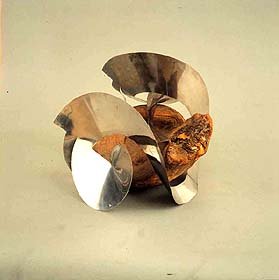LYGIA CLARK
Brazilian Plastic Artist, she was born in Belo Horizonte (MG) on October23rd, 1920 and she died in Rio de Janeiro (RJ) on May 25th, 1988. She decided to abandon Belo Horizonte and her traditional family of juriststo dedicate to art. Lygia Clark didn't stop revolutions, opening perspectives to the Contemporary Brazilian Art.

She was trying to overcome the limits between work and life, she rejected the orthodoxy of "concretismo", she founded a new movement and she tried body art, and started working with"plurissensorial" art. Living in the threshold between psychoanalysis and artistic expression, she dedicated the very label of "artist", demanding tobe called "propositora". When she was leaving home (1947), she had alreadyhad three children, and she started to study painting under the orientation of Burle Marx. In 1950, she went to Paris, where she attended Fernand Lêger's atelier.
When she returned to Rio de Janeiro, she was a member of the Front Group (1954and 1956), led by Ivan Serpa. Aiming at establishing a new abstract language in Brazilian Art, she founded the "neoconcretismo" (1959). In her firstpaintings (1954 – 1958), she changed the nature and direction of thepicture. She extended the color to the frame, annulling it or bringing itinside the picture, creating works such as "Superficies Modulares" and "Contra-Relevos". In the period between 1960 and 1964, she made "Bichos": articulated sculptures manipulated by the audience.

With them Lygia indicated what she was looking for: the participation of the spectator inher work, by sensorial objects (plastic bags, rocks, shells, gloves, etc),to awake sensations and fantasies. She elaborated later work such as "Nostalgia do Corpo: Diálogo" (1968), though which she calls the spectatorto feel simple things, such as the blow of the breath and the contact with arock in the palm of the hand; "A Casa é o Corpo: Labirinto" (1968), that simulates a womb to be penetrated by the visitor, who is led to try tactilesensations when passing through compartments; and "Baba Antropofágica"(1973), in which some people drop lines out of their mouths to someone lyingon the floor.

Lygia developed therapeutical experiences with the sensorial objects, mainlyamong her pupils of Sorbonne, where she taught (1970 – 1975). In Rio de Janeiro, she started to give private therapeutical consultations (1978 –1985).
Project from
Marcia Milanelo
Steps 8
Teacher Laura
Centro Britânico
Pompéia Branch

0 Comments:
Post a Comment
<< Home